March 8: We had time for only one more stop in Florida, and decided to spend it in Crystal River to see the manatees.
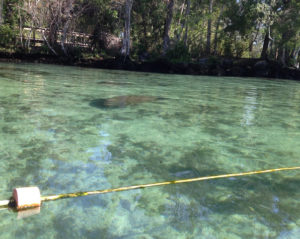 Manatees are large (1/2 ton) herbivorous aquatic mammals. They do not have blubber, so keeping up their internal temperature during a cold snap is difficult. The Crystal River estuary has a number of natural springs which emerge at 72F all year. The manatees use these like a hot tub, and hang out there when their feeding grounds in the Gulf of Mexico are too cold. They eat sea grass, which grows in the shallow waters of the coast and looks like the cellophane “grass” in Easter baskets. It does not grow in the area of the springs, but does grow in the brackish water of the river mouth nearby.
Manatees are large (1/2 ton) herbivorous aquatic mammals. They do not have blubber, so keeping up their internal temperature during a cold snap is difficult. The Crystal River estuary has a number of natural springs which emerge at 72F all year. The manatees use these like a hot tub, and hang out there when their feeding grounds in the Gulf of Mexico are too cold. They eat sea grass, which grows in the shallow waters of the coast and looks like the cellophane “grass” in Easter baskets. It does not grow in the area of the springs, but does grow in the brackish water of the river mouth nearby.
In short, the colder the weather, the more likely you are to see manatees in the springs around Crystal River. On the other hand, the colder you are likely to be if you are in or on the water to view them. We had a pretty good compromise – since it was a warm winter, the place was not exactly swarming with manatees, but we saw a satisfactory number. The manatee in the picture above is resting in a sanctuary area close to the entrance to Three Sisters Spring, one of their favorite hangouts.
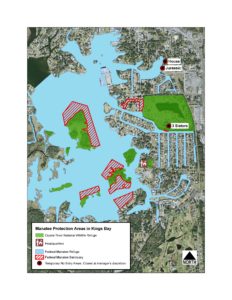 The Crystal River estuary is not exactly what you think of when you think of a nature preserve for large mammals. The map shows Kings Bay. All of the red areas are parts of the reserve. The many straight waterways are canals cut into the residential districts so that people can dock their boats in their backyards. All of these are lined with nice houses, each with a dock and most with a reasonably large boat. These predate the preserve, which was not established until 1983. The red areas are the preserve, where humans are not allowed during manatee season. The manatee above is in a reserve area marked off with buoys. Boats are allowed throughout the Bay, but only at idle speed. Apparently propellers do not kill manatees, but high speed impacts do.
The Crystal River estuary is not exactly what you think of when you think of a nature preserve for large mammals. The map shows Kings Bay. All of the red areas are parts of the reserve. The many straight waterways are canals cut into the residential districts so that people can dock their boats in their backyards. All of these are lined with nice houses, each with a dock and most with a reasonably large boat. These predate the preserve, which was not established until 1983. The red areas are the preserve, where humans are not allowed during manatee season. The manatee above is in a reserve area marked off with buoys. Boats are allowed throughout the Bay, but only at idle speed. Apparently propellers do not kill manatees, but high speed impacts do.
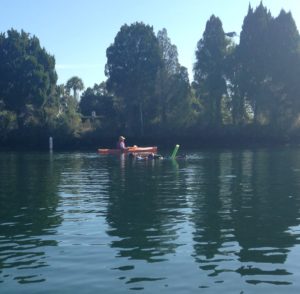 The most peculiar part of the reserve is the little crescent beside the big green area. This is a spring-fed canal which is lined with big homes and big boats. However, no-one, including the home owners, is allowed on the water during manatee season. I cannot imagine what political finangling went into making this happen. However, most of the manatees we saw from our kayak were swimming into or out of this area. Here we are at the mouth of the reserve, along with a swimming tour group in the water with a noodle for floatation and hovering over a manatee. Swimmers are required to stay at the surface, and all the touring companies ensure this by requiring everyone to swim with a noodle.
The most peculiar part of the reserve is the little crescent beside the big green area. This is a spring-fed canal which is lined with big homes and big boats. However, no-one, including the home owners, is allowed on the water during manatee season. I cannot imagine what political finangling went into making this happen. However, most of the manatees we saw from our kayak were swimming into or out of this area. Here we are at the mouth of the reserve, along with a swimming tour group in the water with a noodle for floatation and hovering over a manatee. Swimmers are required to stay at the surface, and all the touring companies ensure this by requiring everyone to swim with a noodle.
The big green area on the map on the mainland is the marsh surrounding Three Sisters Spring, which is the most popular area among the manatees (and hence among tourists). When it is cold, several hundred manatees congregate at the spring. There is a boardwalk so that the manatees can be observed from above. When the numbers are more moderate, it is also possible to take a tour to the entrance to the spring, and swim in with a guide. (This is not a red area, but boats are excluded. The entrance is only a few feet across, which means that when the authorities want to exclude swimmers, they can just station a ranger there. There always seems to be a ranger on land and another in a kayak to monitor the human traffic.)
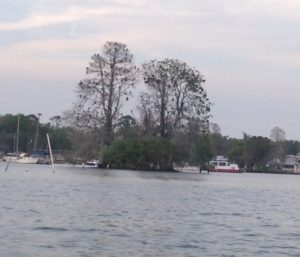
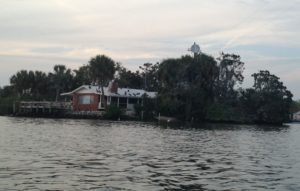 Our first evening in Crystal River we launched in the bay just north of the 3 Sisters. It was a lovely kayak trip, but we had a long paddle against the wind to the spring. We saw lots of big birds including brown and white pelicans but only a couple of manatees visible in the crescent. These two trees and this house on the water appeared to be favorite brown pelican roosting sites. The white pelicans prefer the buoys in the bay.
Our first evening in Crystal River we launched in the bay just north of the 3 Sisters. It was a lovely kayak trip, but we had a long paddle against the wind to the spring. We saw lots of big birds including brown and white pelicans but only a couple of manatees visible in the crescent. These two trees and this house on the water appeared to be favorite brown pelican roosting sites. The white pelicans prefer the buoys in the bay.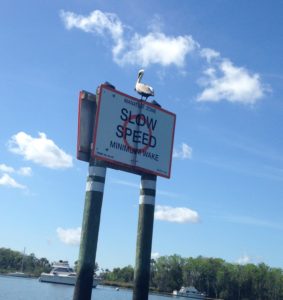
We noted some blue buoys that would go under water and the pop to the surface. Often a manatee would then surface beside the buoy. We thought these were remote-control submarines observing the manatees, but later learned that these are tags, attached by a tether to a band around the narrow part of the tail. These tags are used for studies and to monitor manatees that have been rehabilitated to the wild.
There were several tour boats and kayaks waiting at the entrance to the spring, but we were told that a noisy group had spooked the manatees. Since dusk was fast approaching, we paddled back (again against the wind) getting lots more views of the bird life and seeing a lot of leaping mullet (a type of fish).
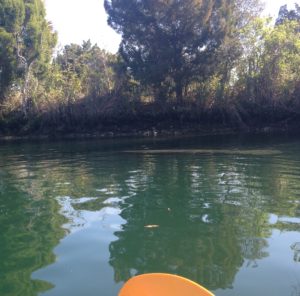 The next day we set out at 8 a.m. and launched from Pete’s Pier, which is much closer to 3 Sisters. Although manatees like to be warm, they do not like to swim against the tide, which was going out. Hence, there were very few manatees in the spring. After paddling out to the feeding areas and seeing nothing there, we paddled back to the channel
The next day we set out at 8 a.m. and launched from Pete’s Pier, which is much closer to 3 Sisters. Although manatees like to be warm, they do not like to swim against the tide, which was going out. Hence, there were very few manatees in the spring. After paddling out to the feeding areas and seeing nothing there, we paddled back to the channel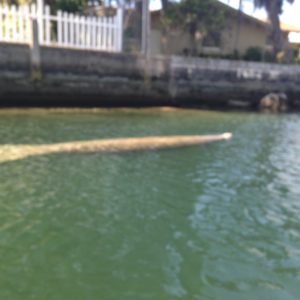 between the bay and the spring, and spotted quite a few manatees traversing the channel in small groups.
between the bay and the spring, and spotted quite a few manatees traversing the channel in small groups.
We got to be quite good at spotting their ghostly shapes in the water and their backs or snouts when they came up for air. Our location in the channel had another advantage – we were well away from the tour boats taking swimmers out to swim with the manatees. This sequence of 4 pictures are all the same manatee, which surfaced beside my kayak.
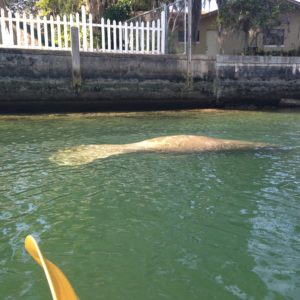
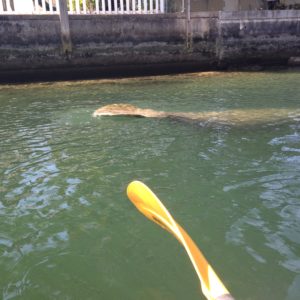 Notice that we (and the manatee) are in the canal that leads from King’s Bay to Three Sisters Spring and is completely lined with houses.
Notice that we (and the manatee) are in the canal that leads from King’s Bay to Three Sisters Spring and is completely lined with houses.
We decided that we would also like to swim with the manatees. A tour seemed like the best idea, as at minimum snorkels and masks are needed, and a wet suit seemed like a good idea. Given what we knew about the tides, we set on Friday for a 9:00 tour, which got us in the water by 10.
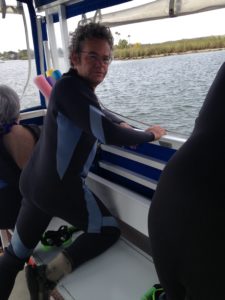
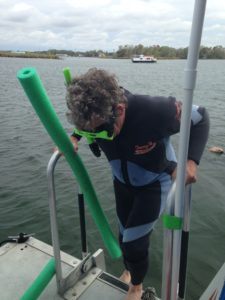
Unfortunately, it was a warm day, so the manatees were not congregating in the spring. Instead our boat took us out to the feeding grounds. Water clarity was poor and there was a stiff breeze, which made the water choppy. However, our guide was very good at spotting manatees both from the boat and in the water.
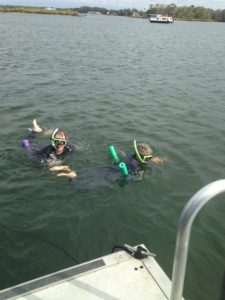 There were 10 of us, which is quite a crowd for the manatees (although it was much smaller than other groups we saw). Needless to say, there are rules for this – no diving, no putting feet down, no getting too close, no touching unless the manatee approaches you.
There were 10 of us, which is quite a crowd for the manatees (although it was much smaller than other groups we saw). Needless to say, there are rules for this – no diving, no putting feet down, no getting too close, no touching unless the manatee approaches you.
From the water, with poor visibility due to murk, it was hard to spot manatees. I had two general rules – stick with the guide, and when people spotted a manatee, move to where it was headed, rather than follow the crowd (a principle I learned from Wayne Gretsky’s advice on receiving a hockey puck). As a result of having a good guide and following these rules, I had some pretty close encounters with several manatees.
With the lighting conditions as they were, a manatee feeding or resting on the bottom looked much like a patch of white sand (which are common in the bay). On several occasions when I was swimming over a “patch” it detached from the bottom and I found myself directly above a surfacing manatee. Since I was pretty sure that no manatee wanted to surface with me clinging to its back, and since one is supposed to move slowly and quietly, I had a few moments of panic as I tried to sidle slowly and quietly away. This never seemed to work. However, I guess the manatees knew I was there, because I was never bumped. I did stroke a few sand-papery backs. I also spent a fair amount of time floating over manatee tails (which are the only part I could reliably identify when they were more than a few feet below me). Fortunately, manatees do not move their massive tails very quickly.
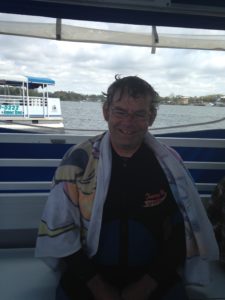 All in all, it was an exciting experience. The manatees did not see to mind – at least they hung around where we were swimming (and they can move away quickly when they want to). We were in the water for just over an hour – and even with the wet suits we were freezing by the time we got out.
All in all, it was an exciting experience. The manatees did not see to mind – at least they hung around where we were swimming (and they can move away quickly when they want to). We were in the water for just over an hour – and even with the wet suits we were freezing by the time we got out.
Our last day in Crystal River, Chuck just wanted to relax at the campsite. Rumple woke me up early (of course) so I decided to bike out to one of the Florida birding trails close to the RV park. It turned out to be very close – perhaps a 1/2 mile away. The trail opened fairly quickly onto what I suppose is another spring – a very nice pond. However, there were very few birds, just a few herons and a bald eagle. The trail was also pretty short. Still, it was a nice morning jaunt.
We had selected the campground because it is on one of the canals leading to the Crystal River. In the late afternoon we launched the kayaks into the canal. Unfortunately, the canal is quite short, and we were sufficiently far from manatee habitat that boat speeds on the river were scary for two people in a kayak. Our excursion was short.
We were blessed with perfect weather in Crystal River, and when not kayaking, we were happy to sit outside and relax. The campground had a little ice cream stand which Chuck enjoyed. But in the evening, despite the perfect weather, we were driven inside. Mosquito-borne Zika might be the most serious problem in the area, but the most annoying bugs are gnats – you may never see one, but in the evening any bare skin is a target, and the bites itch, too.
This was the first campground we were in that actually had organized social activities in the form of a potluck, card evenings and bingo. But we were lazy and stayed in the RV instead.
